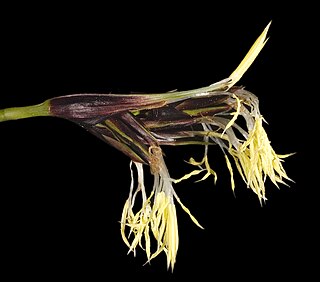
Phyllanthus is the largest genus in the plant family Phyllanthaceae. Estimates of the number of species in this genus vary widely, from 750 to 1200. Phyllanthus has a remarkable diversity of growth forms including annual and perennial herbs, shrubs, climbers, floating aquatics, and pachycaulous succulents. Some have flattened leaflike stems called cladodes. It has a wide variety of floral morphologies and chromosome numbers and has one of the widest range of pollen types of any seed plant genus.

Phyllanthaceae is a family of flowering plants in the eudicot order Malpighiales. It is most closely related to the family Picrodendraceae.

Breynia is a plant genus in the family Phyllanthaceae, first described in 1776. It is native to Southeast Asia, China, the Indian Subcontinent, Papuasia, Australia, and the island of Réunion.

Glochidion is a genus of flowering plants, of the family Phyllanthaceae, known as cheese trees or buttonwood in Australia, and leafflower trees in the scientific literature. It comprises about 300 species, distributed from Madagascar to the Pacific Islands. Glochidion species are used as food plants by the larvae of some Lepidoptera species including Aenetus eximia and Endoclita damor. The Nicobarese people have attested to the medicinal properties found in G. calocarpum, saying that its bark and seed are most effective in curing abdominal disorders associated with amoebiasis.

Banksia neoanglica, commonly known as New England banksia is a shrub or small tree with leaves that are greenish on the upper surface, whitish with soft hairs on the lower side and spikes of flowers with styles that turn black as they open. It is similar to Banksia spinulosa and was formerly known as Banksia spinulosa var. neoanglica, but differs in that its leaves are wider and have margins that are not tightly turned under. It is found mainly along the eastern edge of the Great Dividing Range.

Schoenus is a predominately austral genus of sedges, commonly known as bogrushes, or veldrushes in South Africa. Species of this genus occur mainly in South Africa, Australia and Southeast Asia. Others are found in scattered locations worldwide, from Europe to Asia, North Africa and the Americas. Three species occur in the peatlands of southern South America, including S. antarcticus which is found in Tierra del Fuego, where it forms a component of hyperhumid Magellanic moorland.

Paspaleae is a tribe of the Panicoideae subfamily in the grasses (Poaceae), native mainly to the tropical and subtropical Americas but with a number of species introduced to other regions. It includes roughly 680 species in 39 genera. Species in this tribe use either of the C3 or C4 photosynthetic pathways.
Cyperus crispulus is a sedge of the family Cyperaceae that is native to Australia and found in Western Australia, and the Northern Territory.

Billardiera fraseri is a species of plant in the family, Pittosporaceae, which is endemic to Western Australia.

Tetraria is a genus of flowering plants in the sedge family, Cyperaceae, native to Tanzania, South Africa, Borneo, Australia and New Zealand.
Homoranthus elusus is a plant in the myrtle family Myrtaceae and is endemic to a small area on the Northern Tablelands of New South Wales. It is an shrub with linear leaves and with groups of up to four flowers in leaf axils. It is only known from a single specimen collected near Tenterfield.
Karen Louise Wilson is an Australian botanist.

Phyllanthus calycinus, known as false boronia and snowdrop spurge, is a small shrub in the family Phyllanthaceae, which grows to heights from 20 cm to 1.2 m, often on sandy soils. It is found in both Western Australia and South Australia. In Western Australia its white-cream to pink flowers may be seen from June to January, and in South Australia, from May to October.
Barry John Conn, is an Australian botanist. He was awarded a Ph.D. from Adelaide University in 1982 for work on Prostanthera.
Joy Thompson was an Australian botanist. Her main research areas were taxonomy and Myrtaceae.
Russell Lindsay Barrett is an Australian botanist.

Sauropus arenosus is a plant in the family Phyllanthaceae, native to Western Australia and the Northern Territory.

Phebalium verrucosum is a species of shrub that is endemic to New South Wales. It has branchlets densely covered with white scales, narrow elliptic, oblong or linear leaves covered with white scales on the lower side, and umbels of creamy white flowers with silvery or rust-coloured scales on the back of the petals.
Kelly Anne Shepherd is an Australian botanist, who has published some 91 names.
Paul Edward Berry is an American botanist and curator. He is Director of the Wisconsin State Herbarium.










